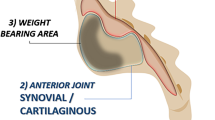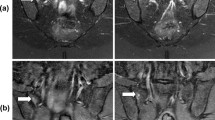Abstract
Objectives
To determine the diagnostic value of MR signal within the sacroiliac (SI) joint space in spondyloarthritis (SpA).
Methods
A retrospective analysis of MRIs of SI joints was performed in 363 patients, aged 16-45 years, clinically suspected of sacroiliitis. Intra-articular SI joint MR signals were categorized as normal, high T1 signal, fluid signal, ankylosis or vacuum phenomenon (VP). These MRI findings were correlated with the final diagnosis, according to the ASAS criteria. Sensitivity, specificity, and positive and negative likelihood ratios (LR) and predictive values were calculated.
Results
Presence of intra-articular high T1 signal, fluid signal and ankylosis had a specificity of 95.8 %, 95.3 % and 99.5 % for SpA. High T1 signal, fluid signal and ankylosis were present in 38.4 %, 19.2 % and 17.9 % of SpA patients and in 4.2 %, 4.7 % and 0.5 % of patients without SpA, resulting in LR+ of 9.0, 4.1 and 37.9, respectively. VP was present in 13.2 % of SpA patients and in 20.8 % of patients without SpA, resulting in an LR+ of 0.6.
Conclusions
Presence of high T1 signal, fluid signal and ankylosis within the SI joint on MRI have high specificity for SpA. High T1 signal is the most sensitive MRI feature within the SI joint for SpA.
Key Points
• MRI of the SI joints is typically obtained for diagnosis of spondyloarthritis.
• The MR signal within the SI joint itself reflects features of spondyloarthritis.
• Intra-articular high T1 signal, fluid signal and ankylosis are seen in spondyloarthritis.
• The vacuum phenomenon makes spondyloarthritis less likely.





Similar content being viewed by others

Abbreviations
- VP:
-
Vacuum phenomenon
References
Braun J, Sieper J (2007) Ankylosing spondylitis. Lancet 369:1379–1390
Lacout A, Rousselin B, Pelage J (2008) CT and MRI of spine and sacroiliac involvement in spondylarthropathy. Am J Roentgenol 191:1016–1023
Dougados M, Baeten D (2011) Spondyloarthritis. Lancet 377:2127–2137
Jans L, Van Langenhove C, Van Praet L et al (2014) Diagnostic value of pelvic enthesitis on MRI of the sacroiliac joints in spondyloarthritis. Eur Radiol 24:866–871
Lambert RG, Salonen D, Rahman P et al (2007) Adalimumab significantly reduces both spinal and sacroiliac joint inflammation in patients with ankylosing spondylitis: a multicenter, randomized, double-blind, placebo-controlled study. Arthritis Rheum 56:4005–4014
Smolen JS, Braun J, Dougados M et al (2014) Treating spondyloarthritis, including ankylosing spondylitis and psoriatic arthritis, to target: recommendations of an international task force. Ann Rheum Dis 73:6–16
Sieper J, Rudwaleit M, Baraliakos X et al (2009) The Assessment of Spondyloarthritis International Society (ASAS) handbook: a guide to assess spondyloarthritis. Ann Rheum Dis 68:ii1–ii44
Herregods N, Jaremko JL, Baraliakos X et al (2015) Limited role of gadolinium to detect active sacroiliitis on MRI in juvenile spondyloarthritis. Skeletal Radiol 44:1637–1646
Weber U, Pedersen SJ, Østergaard M et al (2012) Can erosions on MRI of the sacroiliac joints be reliably detected in patients with ankylosing spondylitis? - A cross-sectional study. Arthritis Res Ther 14:R124
Maksymowych WP, Wichuk S, Chiowchanwisawakit P, Lambert RG, Pedersen SJ (2014) Fat metaplasia and backfill are key intermediaries in the development of sacroiliac joint ankylosis in patients with ankylosing spondylitis. Arthritis Rheumatol 66:2958–2967
Maksymowych WP, Wichuk S, Chiowchanwisawakit P, Lambert RG, Pedersen SJ (2015) Development and preliminary validation of the spondyloarthritis research consortium of Canada magnetic resonance imaging sacroiliac joint structural score. J Rheumatol 42:79–86
Gohil I, Vilensky JA, Weber EC (2014) Vacuum phenomenon: clinical relevance. Clin Anat 27:455–462
Lo SS, Atceken Z, Carone M, Yousem DM (2011) Sacroiliac joint vacuum phenomenon—underreported finding. Clin Imaging 35:465–469
Spadaro A, Iagnocco A, Baccano G, Ceccarelli F, Sabatini E, Valesini G (2009) Sonographic-detected joint effusion compared with physical examination in the assessment of sacroiliac joints in spondyloarthritis. Ann Rheum Dis 68:1559–1563
Maksymowicz H, Kowalewski K, Lubkowska K, Zołud W, Sąsiadek M (2010) Diagnostic value of gadolinium-enhanced MR imaging of active sacroiliitis in seronegative spondyloarthropathy. Pol J Radiol 75:58–65
Rudwaleit M, Jurik AG, Hermann KG et al (2009) Defining active sacroiliitis on magnetic resonance imaging (MRI) for classification of axial spondyloarthritis: a consensual approach by the ASAS/OMERACT MRI group. Ann Rheum Dis 68:1520–1527
Giraudo C, Magnaldi S, Weber M et al (2016) Optimizing the MRI protocol of the sacroiliac joints in Spondyloarthritis: which para-axial sequence should be used? Eur Radiol 26:122–129
Arnbak B, Jensen TS, Egund N et al (2016) Prevalence of degenerative and spondyloarthritis-related magnetic resonance imaging findings in the spine and sacroiliac joints in patients with persistent low back pain. Eur Radiol 26:1191–1203
Landis JR, Koch GG (1977) The measurement of observer agreement for categorical data. Biometrics 33:159–174
Jans L, Coeman L, Van Praet L et al (2014) How sensitive and specific are MRI features of sacroiliitis for diagnosis of spondyloarthritis in patients with inflammatory back pain? JBR-BTR 97:202–205
Lories RJ, Schett G (2012) Pathophysiology of new bone formation and ankylosis in spondyloarthritis. Rheum Dis Clin North Am 38:555–567
Acknowledgments
The scientific guarantor of this publication is Lennart Jans. The authors of this manuscript declare no relationships with any companies whose products or services may be related to the subject matter of the article. The authors state that this work has not received any funding. No complex statistical methods were necessary for this paper. Institutional Review Board approval was obtained. Written informed consent was obtained from all patients in this study. Methodology: retrospective, diagnostic or prognostic study, performed at one institution.
Author information
Authors and Affiliations
Corresponding author
Rights and permissions
About this article
Cite this article
Laloo, F., Herregods, N., Varkas, G. et al. MR signal in the sacroiliac joint space in spondyloarthritis: a new sign. Eur Radiol 27, 2024–2030 (2017). https://doi.org/10.1007/s00330-016-4587-9
Received:
Revised:
Accepted:
Published:
Issue Date:
DOI: https://doi.org/10.1007/s00330-016-4587-9



